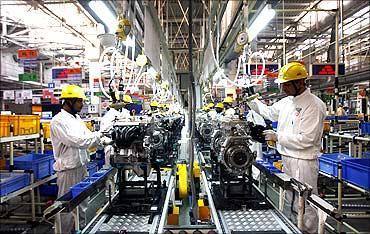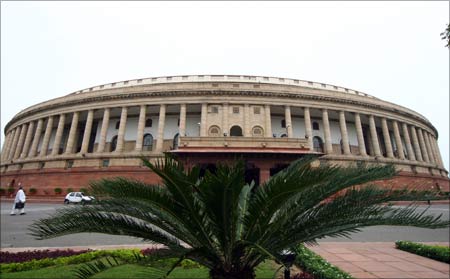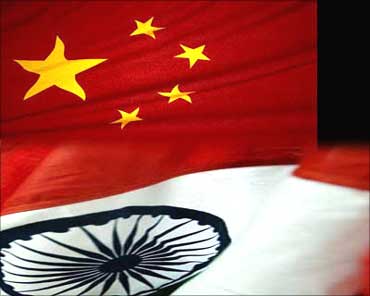 | « Back to article | Print this article |
10 reasons why one should do business in India
Reserve Bank of India recently painted quite a gloomy picture for the Indian economy and rating house Moody's too pointed out how corruption and scams are hampering the country's business environment.
However, things are not as bad as it seems.
For, quite a few contradictory statements are doing the rounds as well.
According to research firm Dun and Bradstreet, India will become a $5.6 trillion economy by 2020.
The firm has also predicted a three-fold jump in the country's gross domestic product, from $1.7 trillion last fiscal, on the back of rapid investment and growing consumer expenditure.
In Eurobrandsindia.com, Andreas De Rosi cited 10 pertinent reasons for doing business in India at present.
We focus on 10 positive aspects of the Indian economy. Read on. . .
10 reasons why one should do business in India
1. India's GDP is on a roll
India's gross domestic product is reaching new heights every year.
India is now the 11th biggest economy in the world.
The GDP expanded 7.7 per cent in the second quarter of 2011 over the previous quarter. From 2000 to 2011, India's average quarterly GDP growth was 7.45 per cent.
India reduced poverty by about 10 percentage points from 1997.
Click NEXT to read further. . .
10 reasons why one should do business in India
2. India's trade is growing steadily
India's imports are increasing more than 25 per cent year on year (since 1960).
Even if 2009 saw a small fall-back due to global recession, in 2010 imports were however again growing at 32.2 per cent (August, 2010 -- year on year growth) and reached over $140 billion (2010).
Click NEXT to read further. . .
10 reasons why one should do business in India
3. India's FDI is on the rise
India's foreign direct investment has been increasing significantly since the past five years.
There are three major countries that are known to be the biggest foreign direct investors in India.
Topping the list of India's foreign direct investment ranking is the small island nation called Mauritius.
This country is located very close to India and enjoys very small tax rate.
This is the reason why many companies set up their businesses there or invest in the existing organisations.
The tax levied is no more than 3 per cent.
In the second place is Singapore, which invests funds in almost the same sectors as the United States, though Singaporeans are also interested in the transportation sector.
Coming in at third place is the United States, which bring in more than $15 billion into the country.
Most of the US investments are placed in the areas of telecommunications, services (usually offshoring), power, oil refinery, food processing, and electrical equipment.
Click NEXT to read further. . .
10 reasons why one should do business in India
4. India is turning into an industrialised economy
India is moving from being an agriculture based economy to an industrialised and service focused economy similar to the US, Europe and other industrialised countries.
India is now the world's biggest manufacturer of small cars.
India is ranked 12th in the world in terms of nominal factory output.
The Indian industrial sector underwent significant changes as a result of the economic reforms of 1991.
Click NEXT to read further. . .
10 reasons why one should do business in India
5. India's population keeps on growing
In terms of population, India is the second largest country in the world.
By 2025, India will be the biggest country in terms of population.
Western markets like the European Union and the United States are set to benefit from a 1.15 plus billion population in India.
The population will continue to grow also in terms of disposable income and consumption of Western products.
Click NEXT to read further. . .
10 reasons why one should do business in India
6. There are 771 million mobile phone subscribers in India
More than half the population owns a mobile phone in India now.
India is the world's fastest growing wireless market, with 771 million mobile phone subscribers as of February 2011.
It is also the second largest telecommunication network in the world in terms of number of wireless connections after China.
Click NEXT to read further. . .
10 reasons why one should do business in India
7. Wireless technology to boost India's Internet access
Wireless Internet is going to massively increase the access of hundred of millions of Indians across the subcontinent.
A new era awaits the country's 584 million mobile phone users, with a faster and more robust Internet, and better access to data services including e-commerce, social networking and telemedicine.
Also ready are mobile device manufacturers with a slew of 3G handsets; providers of hosting, billing and network management services with expanded offerings; and content providers selling cell phone ring tones, wallpapers and graphics.
Click NEXT to read further. . .
10 reasons why one should do business in India
8. India's GNI per capita is growing
Gross National Income per capita in India in terms of purchasing power parity is increasing.
In less than 10 years, the GNI per capita doubled (from $1,560 in 2000 to $3,250 in 2009).
This means Indian consumers can now afford double as much goods and services as just 10 years back.
Click NEXT to read further. . .
10 reasons why one should do business in India
9. Doing business in India is getting easier
India is among the top 40 nations to have carried out the highest number of business regulation reforms in the last five years, most of these related to introduction of technology to ease business operations.
Nowadays, in just 30 days one can have one's business up and running. Doing business in India is getting easier and investor friendlier year-on-year.
Click NEXT to read further. . .
10 reasons why one should do business in India
10. India & China: New Economic Gravity by 2050
Andreas De Rosi mentions in his article a research paper of Danny Quah, from the London School of Economics.
Quah wrote that the world's economic centre of gravity is projected by 2050 to locate, literally, between India and China.
Observed from the Earth's surface, that economic centre of gravity will shift away from its 1980 location a distance of 9,300 km or 1.5 times the radius of the planet.
So doing business in India is a must for companies with a long-term view.
India will sooner or later come back to the time when it was the biggest economy in the world.
Great news for Indians, indeed!










